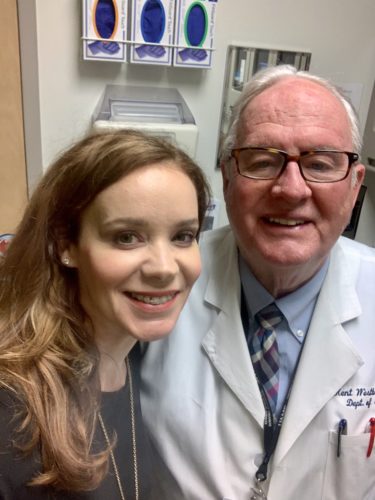Early Melanoma Diagnosis Leads to Positive Outcome for Young Mom
| Achieving the perfect tan is a summertime goal for many young women. But for fair-skinned Kristi Dannelley, getting a golden glow was no easy task.
That’s why she turned to tanning beds.
“I spent hours in tanning beds as a teenager and in my early 20s,” said Dannelley, president of Magna IV in Little Rock. “I quit in my mid-20s, but the damage was already done.”

Kent Westbrook, M.D., performed outpatient surgery to remove a melanoma from Kristi Dannelley’s thigh.
According to the American Academy of Dermatology, visits to tanning beds are never safe. Even one tanning session can increase a person’s risk of all types of skin cancer, including melanoma by 20%, squamous cell carcinoma by 67% and basal cell carcinoma by 29%.
Unfortunately, Dannelley found herself among these statistics at an early age.
“Over the years, I had many suspicious spots on my skin and underwent upwards of 20 biopsies. Many of them were precancerous, but none were malignant,” said the mother of two sons, ages 11 and 14.
Then, in 2013, Dannelley, of Benton, received surprising news. Her most recent biopsy revealed melanoma on her thigh.
“I was a bit shocked when I got that call from my dermatologist. I had undergone so many biopsies over the years that I wasn’t really even thinking about the results of that one,” said Dannelley, who was 37 at the time.
Skin cancer is the most commonly diagnosed cancer in the United States, and melanoma is by far the deadliest type. According to the American Cancer Society, about 100,350 new cases of melanoma will be diagnosed in the United States in 2020 and about 6,850 people will die from it.
Since she is vigilant about regularly checking her skin and having suspicious spots examined, Dannelley’s melanoma was found in a very early stage, when treatment is less complex and more effective.
Taking control of the situation, she researched the most qualified melanoma surgeons in Arkansas and found Kent Westbrook, M.D., at the UAMS Winthrop P. Rockefeller Cancer Institute.
“I had an appointment with Dr. Westbrook within four days and underwent outpatient surgery within a week of calling his office,” she said.
Westbrook is co-founder of the UAMS Cancer Institute and a distinguished professor in the UAMS College of Medicine Department of Surgery.
“Kristi had a very thin melanoma at only 0.41 mm. With a melanoma under 1 mm there is almost a 100% chance of cure, although we can’t guarantee that outcome,” Westbrook said.
Dannelley’s surgery was simple and did not require a lymph node biopsy. No further treatment was required, and she has been cancer-free for seven years.
“Anyone who has a melanoma, especially someone as young as Kristi, has about a 5% chance of developing a new one sometime during their lifetime. It’s important for her to continue self-exams and regular visits with her dermatologist,” Westbrook said.
People previously diagnosed with melanoma should check monthly for brown spots or nodules in or near their surgical scar. They also should feel for swelling in the lymph nodes that drain that area, which would be located either under the arm, in the groin or neck.
Those who have never been diagnosed with melanoma or other types of skin cancer, should check their skin monthly for new moles or for a mole that changes shape, turns black, gets larger or bleeds.
“Almost no one is born with moles. You develop them during your teenage years, and by your early 20s they are stabilized. If they change after that, you need to have it looked at by a doctor,” Westbrook said.
Now, when Dannelley enjoys her family’s favorite outdoor activities, she is careful to cover up and apply plenty of sunblock.
Her husband, Scott, supports her attempts to limit sun exposure, even going so far as to build a cover over her kayak so she can safely enjoy her new favorite water sport.
“Prevention is so important. When you do have a mole that worries you, check it out. The earlier you catch it, the easier it is to treat, and that makes the process so much easier on you and your family,” she said.
